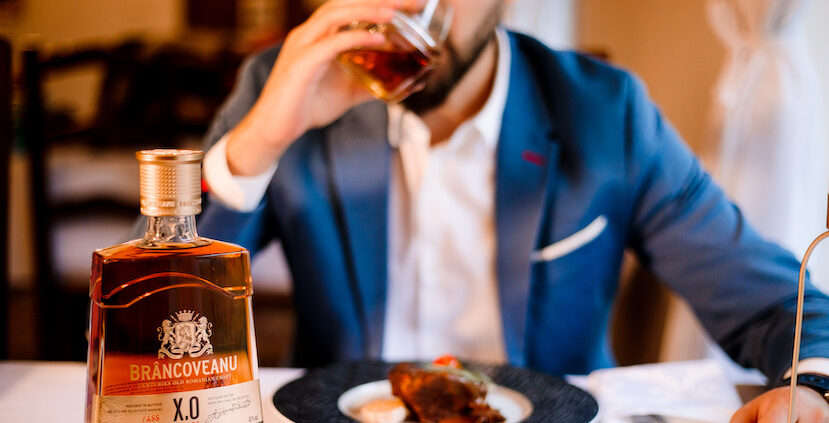
Romania is no stranger to a bewitching potion. For centuries, uncles, cousins, and fathers-in-law have laboured over pots of boiling țuică in rural homemade plum sheds, contesting whose traditional Romanian spirit delivers the most fire. North of Bucharest, within cobbled Transylvanian towns like Brașov and Sinaia and at ski resorts cradled by the forested slopes of the Carpathian Mountains, Hutsul specialties like cast-iron-cooked banush and cornflour loaf are washed down by pints of apple-toned Timisoreana. Between Bucharest and Brașov, the Big Hill Region is sown with wine estates and wine cellars, with more than one métier in the form of sparkling, red, white, and rosé. Whether liquid-based or solid, and whether musky, mature, crisp, or starchy, Romania’s distinct flavours reign strong in the refined restaurants of burly Bucharest too. Yet, a luxury getaway in central-south Romania doesn’t have a single orbit in the culinary stratosphere. Castles cling onto grooves in the Carpathian slopes, and in Bucharest, there are historic hotels, fine-dining Art Nouveau restaurants, and royal locations which ignite the same zest and romance as Romanian drinks and cuisine.
With a cuisine that favours starchy white breads, cheeses, and dense meats such as mici, slănină, and jumari, any Romanian victuals would be incomplete without a complimentary liquid. Tuică’s classier sibling and Romania’s beau since 1892, the Rhein Extra sparkling wine of the Romania-born Alexandrion Group has been the supplier for everything from Bucharest-based fine dining restaurants and shelves in far-flung European corner shops to the well-accustomed lips of the Royal House of Romania. Romania’s first single malt whisky, the Carpathian Single Malt Whisky, is a newcomer on the scene. Spun from the virgin forests and sub-Carpathian water of the Carpathian Mountains, it is now just as essential to any luxury Romanian drinks or gastronomy itinerary as experiencing Romania’s 6000-year-old winemaking tradition. The latter entails swilling reds brewed from the beelined vineyards of the Big Hill Region or sampling the sparkling wine of Sinaia’s cellars.

Following a muddled history of multiple invasions by Magyars, Turks, Russians, and others, Romania’s romance with fine-tuned liquor and larder is less ambiguous. When it comes to European wine production, Romania falls just short of the four big European wine extraordinaries, Italy, France, Spain, and Germany. Some of its most notable strains are Tămâioasă Românească, Sauvignon Blanc, Fetească Neagră, Chardonnay, and Viognier. The demand for wine in Romania, and in fact worldwide, has added 187,000 hectares of strapping vineyards to the Dealu Mare (Big Hill) region. Romania’s lengthy winemaking tradition has its inhabitants’ keen appetite to thank too. They have been fermenting moonshine from prunes and plums in rural towns for centuries and sponging it up with slănină, a starchy breakfast of crusty bread, cheese, red onion, and cured pig fat.

Only next door to the Dealu Mare, the Carpathian Mountains is mainly a dwelling for brown bears, luxury ski resorts, pointed castles, and Hutsul cuisine. Cast-iron-cooked banush and cornflour loaf might be enough to rocket the region onto a palatable Romanian voyage. However, the area’s new reigning spirit, the Carpathian Single Malt Whisky, is soon to be as fundamental to any fine dinner in Brașov, Bucharest, or indeed any big European city, as pickles are to polenta or țuică is to breakfast cheese. Fashioned from Romanian malted barley and sub-Carpathian water, and then aged in Romanian, European, and Bourbon barrels, the whisky has all the hallmarks of its country: mature, authentic, and elegant, and unapologetically so.

Romania’s very own Bordeaux, which is otherwise known as the Dealu Mare or the Big Hill Region, brings sparkling wines, reds, and whites like Muscat, Fetească Albă, and Aligoté to the table. As the oldest sparkling wine producer in Romania, The Iconic Estate’s Rhein & Cie Azuga 1892 Cellars have been the official supplier of the Royal House of Romania since 1904. At once a European wine fridge staple and a vision of Romania’s golden age, the sparkling wine was the chosen draft for King Ferdinand I and Queen Mary’s 1922 coronation, as well as for wayfarers travelling on the Orient Express between Paris and Constantinople in the early 20th century.

The latest agents in line to test the enduring sparkling Rhein Extra are guests at the Rhein & Cie Azuga 1892 Cellars. Whether you stay overnight at the cellars’ traditional suites, which go for 900 lei (£124.25) per night on weekends, or descend into the cool subterrane just to sample brie, horezu, burdurf, cranberries, and Rhein bubbles, it’s a sure-fire way to experience a small but significant part of Romania’s luxury wine macrocosm.

Lux Garden, a nearby five-star abode among the pines with a garden spa and an à la carte restaurant, is another luxury place to lay your head.

If the Big Hill Region caters to those with a taste for sweet nectars, the Carpathian Mountains serve those with a smokier palette. In Brașov, sample Hutsul dishes like banush cooked in a cast-iron pot over an open fire, or burishnik, a cornflour loaf paired with boiled potatoes. You might try pyrohy, a cheese dumpling, where milk is extracted from the udders of mountain sheep, shaped into clots, and hung out to dry in the sun, or you may pair whisky with bohrach and huliash, Hungarian-Romanian fusions, or the stuffed fish and chovlent brought to Romania by Jewish communities.

While Carpathian Single Malt Whisky is the most fitting of all Romanian drinks for such a location, you might choose to sample more of Romania’s and Alexandrian Group’s refined liquids, which include Brâncoveanu Vinars, Kreskova vodka, SABER Elyzia, and Alexander Gin. The single malt whisky has sweet editions aged in Pinot Noir wine barrels and smokier tones aged in barrels of Fetească Neagră or Madeira. When you’re willing to part with your whisky glass, the mountains have ski resorts and caves, gorges, thermal springs, and sinkholes to visit on foot or by ski.
Streetside sarmale (cabbage rolls), covrigi (pretzels) and ciorbă de fasole (bean soup) aside, Bucharest has plenty of opportunities for refined indulgence. Luxury begins with fashionable sleeping quarters, like Hotel Lido in Romania’s romantic ‘little Paris’. A piece of artwork by interwar architect-artist Ernest Doneaud, the hotel is on the high-end Magheru Boulevard moments from the Calea Victoriei and mashes interwar Revival extravagance with lower-key modern innovation. Come dinnertime, dine in Zaitoone, a pioneer of Lebanese luxury in Romania with Arab dishes like labne, falafel, and beef shawarma. Another premier food destination, Caru’ cu Bere may go by the modest translation ‘the beer wagon’, but the gothic revival building in Bucharest’s Lipscani district designed by Austrian architect Siegrfrid Kofczinsky is the new keeper of the 1879-born restaurant. Surrounded by an Art Nouveau interior, diners inhale dishes such as Black Angus Tomahawk steak and Romanian-style confit pork with smoked sausages, polenta, and braised cabbage.

Drive far enough and it won’t be long until you come across a pointed tower between the European beech, silver firs, and sycamore maples of Romania’s hills. In Sinaia, a former royal city during the reign of the House of Hohenzollern-Sigmaringen, Peleș Castle was erected for King Carol I. The royal summer hunting house and former royal palace has wall-to-ceiling Austrian frescoes, hand-painted murals, rugs from Mosul or Saruk, porcelain from Meissen, stained glass vitralios from Switzerland, and traditional fachwerk reminiscent of a lodge in the Alps. Like many of Romania’s royal residences and castles, it fetches influences from over the globe, whether Florentine, Turkish, Imperial, Mosul, or French. Gifted to Prince Mercea, Bran Castle on the old Wallachia border had a less glamorous role; Teutonic Knights held ground against invasions by Mongolia on a passage in old Romania, before the abode was taken up and restored as a summer getaway by Queen Marie.
Whether you take a brief taste of central-south Romania or a deeper plunge into the many Romanian drinks and cuisine of the Big Hill region, the Carpathians, and Bucharest, one thing is for certain. The flavours should be as fiery as the country’s țuică and as refined as the Carpathian Single Malt Whisky and the Rhein Extra that are derived from its diverse terrains.

